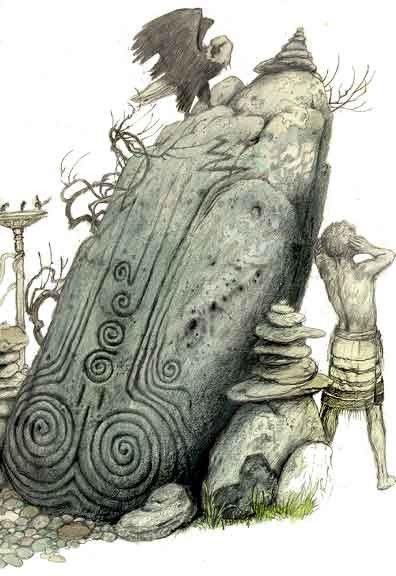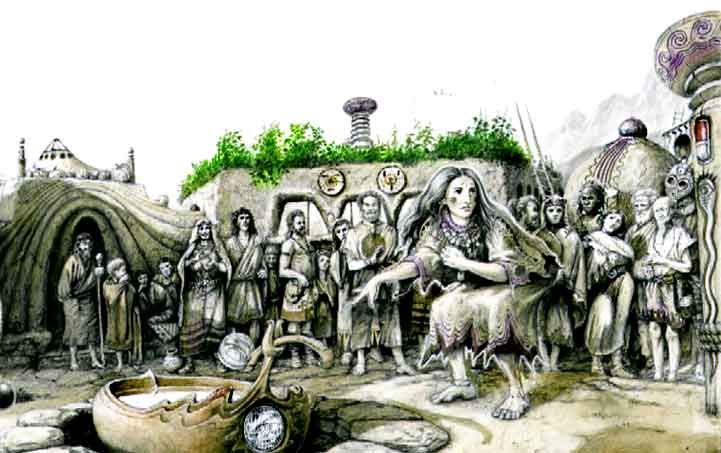Breaking the Technical Trance
Be perfectly clear about where Technoid-science is taking us. We are so used to a constant trickle of bad news that the full enormity of our predicament escapes us. It is clear to the few remaining peoples for whom the earth is still a living thing. When their warnings surface we would be well advised to listen, as the Navaho say, “with our most careful ear.” Such a warning recently came from the Kogi, a secretive people living in the rugged sierra of Columbia, sustaining what may be the last pure Precolumbian culture. The Kogi know us -- Western Civilization -- as a grasping and dangerous race to be avoided: the “Younger Brothers.” Their oral traditions tells of Conquistadors pillaging their gold and enslaving their ancestors, of abandoning coastal towns and retreating higher and higher into the hills. Of watching the forests hewn into plantations, then abandoned as they eroding into desert, and now, of murderous cocaine growers claiming still more of their ancient territory. But only when the rain patterns faltered and the snow caps above them started shrinking did they grasp the magnitude of the Younger Brother’s mistreatment of the earth. Breaking their code of isolation they somehow connected with the BBC, and broadcast a poignant message around the world, their message to the Younger Brothers: Stop or you'll ruin the whole world!
Personal Purification

The next step out of this jam is recognizing that most of civilization’s addictions, obsessions, and greeds are lodged inside our own beings. Did we think that they were somebody else’s problem? Truth: there’s not going to be any real change outside unless the goop inside is discarded first. Too bad. We Americans like nothing better than a fight with the bad guys. But that's the old way of thinking, and one of the first things we have to let go of! This understanding gives us a firm handle on the situation. As the poet said, the fault lies not in the multi-nationals but in our selves. This is spiritual purification. Of course there are faults aplenty with the multi-nationals, and noble battles to be fought. But the rules for deep and abiding change are different. The work is at personal ground-zero, and victims and blamers won't get far. If this housecleaning is done right, the multinationals will be a breeze: What if we had a civilization and nobody came? Opening ourselves to this course, new and vital possibilities may emerge.
The Great Purification
Indigenous people have something to say on the matter of purification. In 1981, Hopi spiritual leaders traveled to New York and were granted a special forum at the United Nations, the first ever recognizing the sovereign status of an Indian nation. There they issued a formal notice to all nations: By signs and portents given in ancient prophesy, the world had now entered a passage called the Time of Great Purification. The Great Purification would be a test and a tribulation for all people, everywhere, and would end, for those who passed through it, in an Emergence into a new world.
Storm clouds roil overhead, and unease spreads across the land. Could it be that we have come to these times? Even to a change-of-ages? Have we entered a real paradigm shift, right down to the roots? The real question is no longer have we have arrived at a prophetic moment? but rather, what now?

The Kogi and the Hopi are telling us what scientists have been for some time; we have come to a crisis, even a cusp of history, and things have to change bigtime. But we are a resourceful people, with before us near the whole magnificent spread of mankind's record, the wisdom and the warnings of the ages. Picking through this legacy, certain elements resonate with who we are, who we want to be. Putting them together, do we see the outlines of a workable future? You certainly can’t design a society like a car, but somehow this business doesn't seem as screwy as it might: the last century has cut loose our moorings, and there is an unsettling feeling that everything is very tentative, very pliant.
In fact, just such a patchwork culture seems to be aborning. Sometimes hidden, sometimes on the best seller lists, alternately serious and silly, but very real, and gathering momentum. We can see it being shaped by Men’s and Women’s Groups, Great Mother worshipers, planet drummers, deep ecologists, urban shamans, Rainbow Tribers, New Agers, neo-pagans, Native Americans. And there are diverse ashrams, zendos, esoteric Christian fellowships, Sufi study circles, Tibetan Buddhist gompas taking root all over. All are singularly engaged in lifting the two-dimensional curtain of our materialistic world-outlook and moving into the warmer, multi-leveled domain of spiritual exploration and myth that lies on the other side. As this multitude of minds and hearts loses interest in the old, is it shaping something new? What form would this new American dreamtime cloak itself in if given the opportunity? What would the look and feel of an Afterculture be like? As Robert Bly chants when he begins a tale, we are leaving the ordinary world now. The world of sitcoms and Superbowls, and a whole lot more.

Therefore let
us be archeologists of the future and peer across the times.
Or midwives, seekers of vision.A bit romantic, perhaps, for
hope is needed now, but not foolish, and guided in this
quest by whatever mysterious force does indeed oversee the
fate of people and planets. Or Aftercultures. Amen.
We find a people drawing vitality from the earth and
fascinated by the sacred. Somehow loosened from our dying
techno-culture, they move eagerly and perhaps warily forward
into a time of immense possibilities. The exact
circumstances are vague. It may be after collapse, but
perhaps it is the aftermath of an electrifying, conscious
decision across the land to move in a new direction.
Whichever, here we have a new people, a culture new-born and
open.
It would
probably be more accurate to imagine a rich biodiversity of
cultures being born -- an exhaultation of cultures! There
are a vast number of ecological and mythological niches for
human expression, and the natural impulse of our species is
to be continually and gaily mutating into all of them like a
Darwinian collection of finches .

Cultures might evolve as honed as the bare-boned Kalihari bushmen, or the Mono indians of California. Imagine a shy and retiring people, masters of every secret in their environment, silent movers leaving few traces. But where would they really dwell? Would they wander in the forests of dreamtime as well? Others might be more aggressive, generous and wild-spirited, like Vikings or Lakota. Who knows? The only thing we can say for sure is that the natural variety of our species has been pruned and plowed under too long. We bipeds are most assuredly not creatures of uniform and predictable manners, and when having freed ourselves from the electronic thrall of the monoculture to unfold according to our own inner laws, the relief will be tangible.
Many clues to how true self-sustaining culture work can be found by observing Traditional cultures. Traditional refers to customs that are repeated and established over a long period of time; the implication is of groundedness and stability. Successful traditional cultures find grooves for thousands of years -- while remaining supple and responsive, developing outlooks that nourishes and unify the physical, mental, spiritual and ecological systems
To regard
Traditional, sustainable societies as “stagnated”
is to miss the point. Their relative lack of material things
is uisually balanced by a deep poise and a rich inner life,
complex mythologies, rites of passage, music, and marvelous
esthectic sensibilities. Perhaps they are not
“progressing” in a manner we recognize because
their chief interest is directed in another direction.
It will take an act of will to see that our bustling global
economy is just cover for an obsolete and life-denying
system. Certainly we can envision something better. How
about a future where the deer and the antelope really roam,
and the bison and the wolf and the grizzly as well, and the
rivers run sparkling clean to the sea, and mighty forests
rise again, and we walk in the sacred way of true human
beings, in knowledge and wisdom and beauty?
If that sounds right, we have to begin cutting bait now, and
expertly. The rainforests are burning even as we speak.
We’re going to have to move lightly. What old toys are
we willing to leave behind? What old convictions? The time
for change has come. It will be either cataclysmically, or
consciously.

It signals for a return
to a deep
and refined
and natural
level of harmony.
To magical thinking!
It evokes the Tribe as a natural response to the insanity of modern nations
Perhaps
“tribe” has too many associations to be exactly
the right word, but it is close enough. It suggests
something totally unexpected emerging out of Western
Civilization, an organic social structure intimate with
nature, simple in surface detail but given to exploring
vital territories that civilized societies ignore.
What would an Afterculture be like? What could its people
tell us? If the seeds of a people’s destruction are to
be found within, might the blueprints of future life be
there as well? Do these good folk of the Afterculture
already exist, enfolded in our hopes and dreams and
chromosomes? Like and unlike us, Can they whisper to us back
across the gulf of time? Can they draw us toward
them?
Refrain
fromCheyenne Ghost dance song:
“Hi-niswa’ vita ’ki’ni”
We
shall live again.

